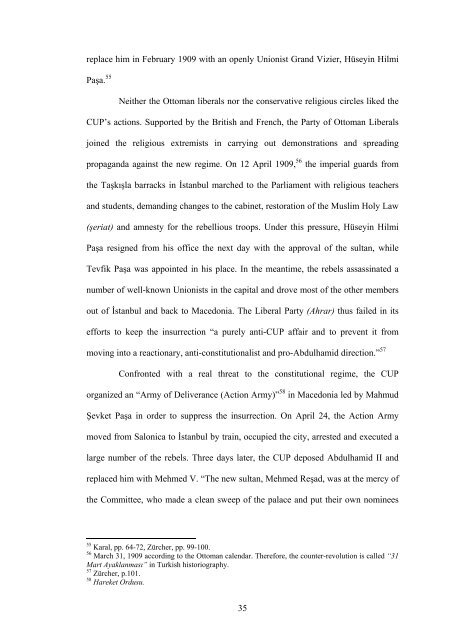the beginnings of ottoman-german partnership - Bilkent University
the beginnings of ottoman-german partnership - Bilkent University
the beginnings of ottoman-german partnership - Bilkent University
You also want an ePaper? Increase the reach of your titles
YUMPU automatically turns print PDFs into web optimized ePapers that Google loves.
eplace him in February 1909 with an openly Unionist Grand Vizier, Hüseyin Hilmi<br />
Paşa. 55<br />
Nei<strong>the</strong>r <strong>the</strong> Ottoman liberals nor <strong>the</strong> conservative religious circles liked <strong>the</strong><br />
CUP’s actions. Supported by <strong>the</strong> British and French, <strong>the</strong> Party <strong>of</strong> Ottoman Liberals<br />
joined <strong>the</strong> religious extremists in carrying out demonstrations and spreading<br />
propaganda against <strong>the</strong> new regime. On 12 April 1909, 56 <strong>the</strong> imperial guards from<br />
<strong>the</strong> Taşkışla barracks in İstanbul marched to <strong>the</strong> Parliament with religious teachers<br />
and students, demanding changes to <strong>the</strong> cabinet, restoration <strong>of</strong> <strong>the</strong> Muslim Holy Law<br />
(şeriat) and amnesty for <strong>the</strong> rebellious troops. Under this pressure, Hüseyin Hilmi<br />
Paşa resigned from his <strong>of</strong>fice <strong>the</strong> next day with <strong>the</strong> approval <strong>of</strong> <strong>the</strong> sultan, while<br />
Tevfik Paşa was appointed in his place. In <strong>the</strong> meantime, <strong>the</strong> rebels assassinated a<br />
number <strong>of</strong> well-known Unionists in <strong>the</strong> capital and drove most <strong>of</strong> <strong>the</strong> o<strong>the</strong>r members<br />
out <strong>of</strong> İstanbul and back to Macedonia. The Liberal Party (Ahrar) thus failed in its<br />
efforts to keep <strong>the</strong> insurrection “a purely anti-CUP affair and to prevent it from<br />
moving into a reactionary, anti-constitutionalist and pro-Abdulhamid direction.” 57<br />
Confronted with a real threat to <strong>the</strong> constitutional regime, <strong>the</strong> CUP<br />
organized an “Army <strong>of</strong> Deliverance (Action Army)” 58 in Macedonia led by Mahmud<br />
Şevket Paşa in order to suppress <strong>the</strong> insurrection. On April 24, <strong>the</strong> Action Army<br />
moved from Salonica to İstanbul by train, occupied <strong>the</strong> city, arrested and executed a<br />
large number <strong>of</strong> <strong>the</strong> rebels. Three days later, <strong>the</strong> CUP deposed Abdulhamid II and<br />
replaced him with Mehmed V. “The new sultan, Mehmed Reşad, was at <strong>the</strong> mercy <strong>of</strong><br />
<strong>the</strong> Committee, who made a clean sweep <strong>of</strong> <strong>the</strong> palace and put <strong>the</strong>ir own nominees<br />
55 Karal, pp. 64-72, Zürcher, pp. 99-100.<br />
56 March 31, 1909 according to <strong>the</strong> Ottoman calendar. Therefore, <strong>the</strong> counter-revolution is called “31<br />
Mart Ayaklanması” in Turkish historiography.<br />
57 Zürcher, p.101.<br />
58 Hareket Ordusu.<br />
35
















